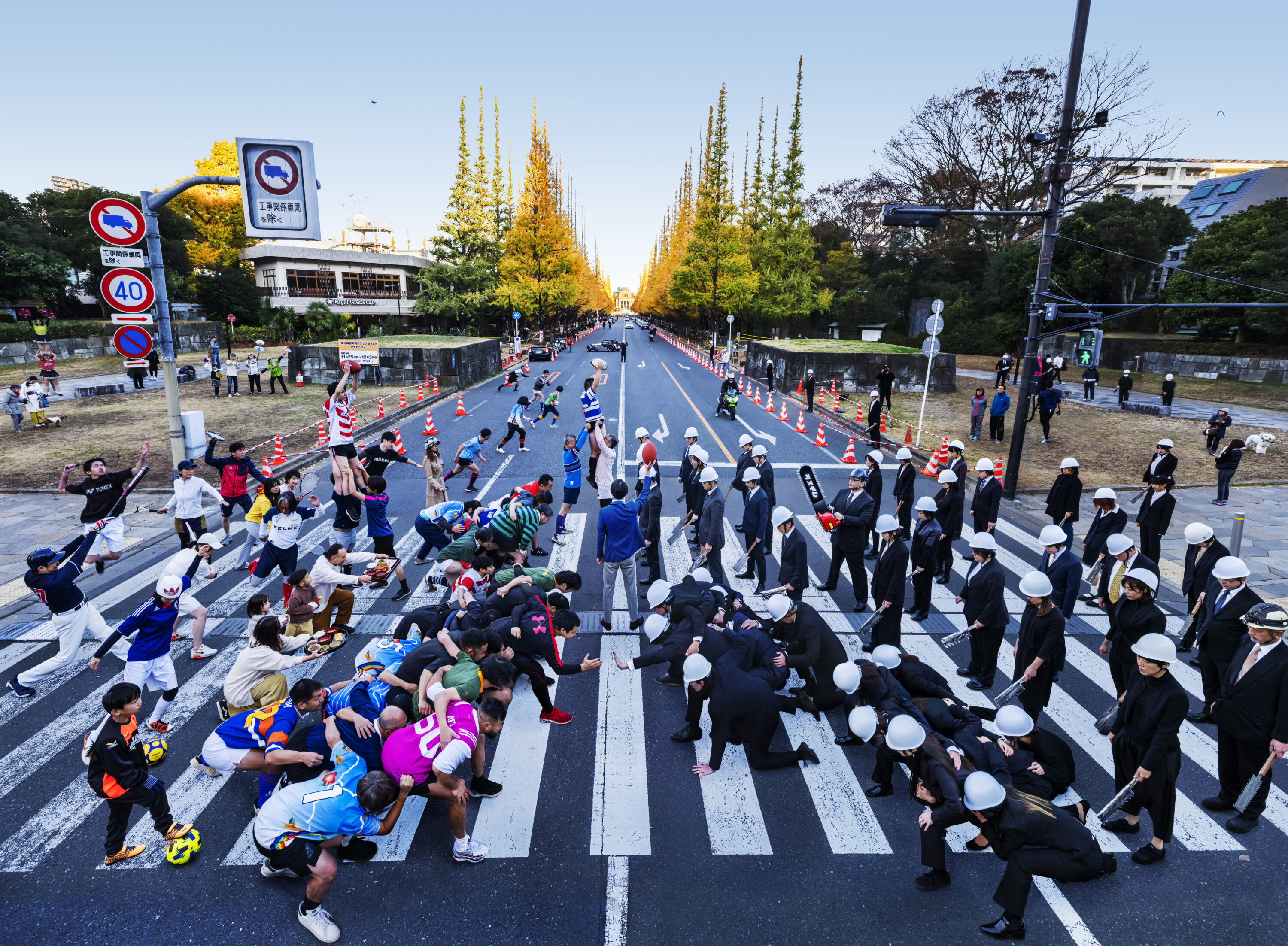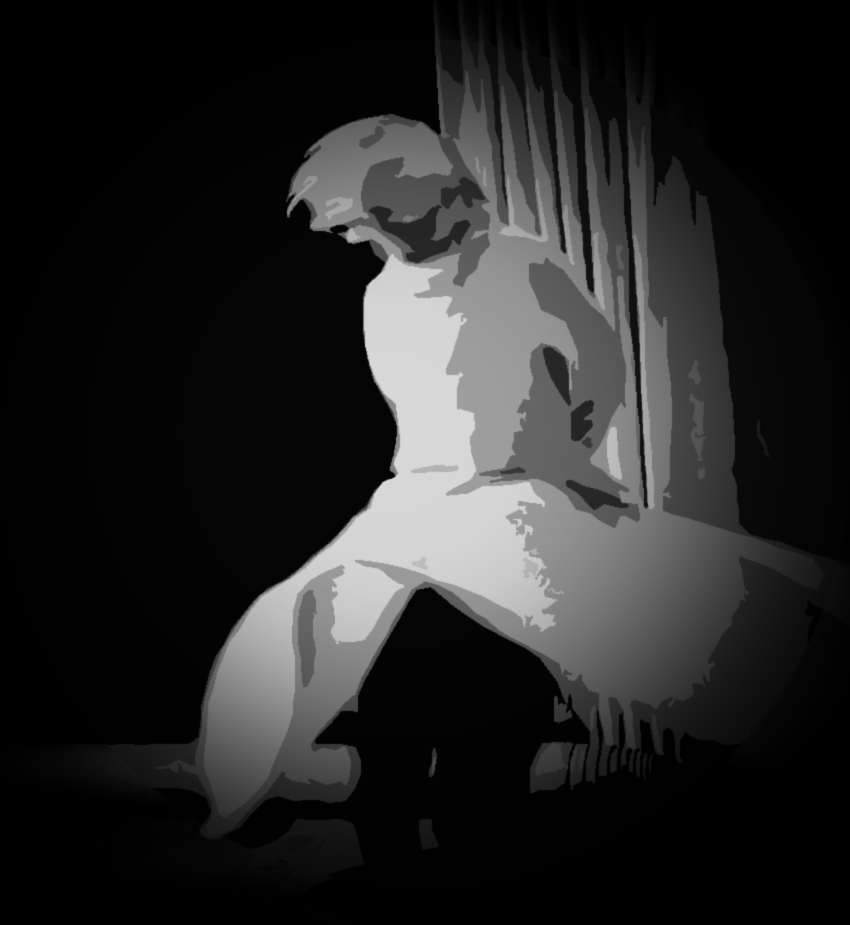KYOTOGRAPHIE KG+セレクト:宇佐美雅浩のコミュニティ万田ラス(2024年4月17日
 写真 © 宇佐美雅浩
写真 © 宇佐美雅浩
「サイレント・ラガーメン、神宮外苑2023
KYOTOGRAPHIE京都国際写真祭のために京都を訪れた2日目、私はメインの写真展から少し離れて、以下の写真展をチェックした。 宇佐美雅弘 (宇佐美雅浩)の展覧会 KG+セレクトのマンダラ 堀川御池ギャラリーでのショー。会場を後にする頃には、見方についての瞑想に導かれていたような気がした。
今年のKYOTOGRAPHIEのテーマは「源流」または「起源」であり、そのテーマに対する彼らの凝りようが興味深い: 「源とは、始まりであり、イニシエーターであり、万物の起源である。それは生命の創造であり、葛藤が生じる場所であり、自由を得る場所であり、何かが発見され、生まれ、創造される空間である。人生の分岐点にかかわらず、私たちは岐路に立っており、原点に戻るか、新しいことを始めるかの間で揺れ動いている。この神聖な空間から、生命、愛、痛みのシンフォニーが響き渡るのだ。"今年のKG+セレクトのアーティストたち、そしてメイン展示のアーティストの多くは、葛藤から進む旅に焦点を当てることを選んだ。
KYOTOGRAPHIEのサテライト・プログラムであるKG+は、新進の写真家たちに特化した100近い展覧会を開催している。KG+セレクトは、KG+内の公募審査展で、KG+アワード2024のグランプリとKYOTOGRAPHIE2025への招待を争う10組のアーティストが参加した。劉興宇が受賞した「The Mail Address is No Longer Valid」もまた、時間的であると同時に関係的な旅を記録したもので、感動的だった。実際、これらの展示はどれも興味深かったが、ここでは正浩の作品だけを取り上げることにする。
マサヒロは、あるコミュニティの旅の本質を理解し、そのコミュニティと協力して捉えるために、時間や空間を超えた関係性の旅に出ることで、アート--正確には写真という形の曼荼羅--を創作している。彼の言葉を借りれば、「(長期にわたる曼荼羅シリーズの)個々の写真には、それぞれ異なる地域や立場の人物が中心に描かれ、その周辺には、ちょうど仏教の曼荼羅画の形のように、その人物の世界を表現する人や物が配されている」。彼が20年以上前に美大で始めた曼荼羅シリーズから、2017年にサイプレスで制作した作品と、2023年に東京で制作した作品の2つのプロジェクトが本展に含まれているが、ここでは後者との出会いを中心に紹介したい。
彼の写真を一目見ると、2組の人々が向かい合っている。曼荼羅展というが、曼荼羅には見えない。幾何学模様に配置された線ではなく、人で構成された曼荼羅ということなのだろうが......。曼荼羅の機能は瞑想中に集中するものを提供することだから、作家は私たちにこの人々の集団に瞑想してほしいのかもしれない。うーん...。
手前中央の多くの人々は、アメリカンフットボール選手のようにしゃがんでいる。この写真のタイトルは「神宮外苑2023」。Silent Rugger Men, Jingu Gaien 2023」。ラグビーのことだろうか?ラグビーのスクラムをイメージしているのだろうか。しかし、彼らは通りの真ん中にいて、右側の人たちは皆、ハードハットと黒いスーツを着ていて、前線の後ろの人たちは棒か何かを持っている。警棒ですか?いや、柄の短いシャベルやチェーンソーのようだ!対照的に、左側のグループはカジュアルでカラフルな普段着を着ており、最前線の後ろにいる人たちはさまざまなアスレチックポーズをとっている。サッカーボール、テニスラケット、野球のバット、サッカーボール......。食べ物の入ったトレーを持っている者もいる。なんとも不思議だ!
つまり、この構図は、一方では "武装した "建設労働者やビジネスマンが、もう一方ではさまざまなレクリエーション活動に従事する人々が、対立している、あるいは対立の危機があることを示唆しているようだ!うーん、何が起こっているのだろう?私はいつも曼荼羅から平和を連想するが、このイメージはまったく平和的ではない。曼荼羅は、心の中にあるどんな考え(厄介な考えも含む)にも注意を向けさせ、その原因を熟考し、よりよく理解し、解決できるようにすることで、平和な心をもたらす手助けをしてくれるのかもしれない。この写真のポイントは、私たちに葛藤の根源を考えさせることなのだろうか?
曼荼羅を作ること自体が瞑想的なプロセスであることを思い出した。この写真の制作には何があったのですか? 明らかに演出された写真だ。だから、そこに写っている全員が、最初はバラバラに見えても、そこにいることを選択し、イメージ作りに協力している。彼らは誰で、なぜこのように配置されているのか?どのような対立を描いているのか?
タイトルは次のようだ。 明治神宮外苑 明治神宮外苑は、東京の中心にあるニューヨークのセントラルパークのような西洋式公園として親しまれている。森に囲まれた遊歩道、水辺、庭園、子供の遊び場、芝生、そしてプロ野球の本拠地である神宮球場や2020年東京オリンピック・パラリンピックの主会場である国立競技場などの文化・スポーツ施設がある。明治神宮外苑の大規模再開発案は、次のような火種をもたらした。 地域からの強力な反発 1926年に明治天皇夫妻を祝って植樹され、庭園の基本的な特徴とされてきたこのイチョウ並木が、多くの樹木の伐採が計画され、公園で愛されてきた四本のイチョウ並木に悪影響を及ぼす可能性があることをめぐって。A 請願 公園の樹木を守り、計画を見直すよう求める署名は20万人を超えた。村上春樹や坂本龍一といった著名人までもが、公に計画の見直しを政府に求めた。もしかしたら、写真に描かれている対立はこのことを指しているのだろうか?そうであれば、木や草木を伐採したり掘り出したりするための道具であるシャベルやチェーンソーの存在も説明がつく。
実際、写真展の説明には「プロジェクトを進めたい開発業者と、進める前にさらなる話し合いを求める市民との対立を描いている」と書かれている。マサヒロは実際に、この写真の制作に参加するためにこれらの人々を集めることができたのだろうか?東京都と巨大な開発会社に電話をかけ、自分たちを強く批判し、プロジェクトを遅らせようとしている人たちとこのようにポーズをとるために、大勢の社員を公園に派遣するよう依頼することを想像してみてほしい!
正博が多くの時間を費やして彼らと知り合い、彼らの懸念に耳を傾け、彼らの視点や公園に対するビジョンを理解していたからこそ、このような形で関係者を集めることができたのだ。彼が何度も関係者を訪ね、話をするうちに、彼らは彼の目的が彼らを批判することでも、味方することでもないことを信じるようになったに違いない。彼はまた、このプロジェクトが彼らに害を与えないだけでなく、公正かつ品位ある方法で、彼ら全員を肯定的に描き、彼らの時間と労力に見合う方法で、相当数の人々にとって大きな関心と重要性を持つ状況の本質を正確かつ芸術的に表現するものであることを確信させたのだと思う。
さらに、この画像には対立の解決は描かれていないが、両者がある程度、相違点を超越した形で協力し合っている様子が描かれている。それは、彼らがより大きなコミュニティと分かち合った立派な成果である。それゆえ、この写真は参加者全員が行った旅の集大成であり、互いを理解し、プロジェクトそのものを理解するための旅なのである。この旅路のさらなる証拠となるのが、マサヒロが写真と一緒に展示している写真の下絵であり、関係者と協力して練り上げた構図である。
 写真 © 宇佐美雅浩
写真 © 宇佐美雅浩
宇佐美雅浩は、時空を超えた関係性のある旅をすることで、ある共同体の旅の本質を理解し、その共同体との共同作業によってとらえる写真曼荼羅というアートを創作している。彼の言葉を借りれば、「(長期にわたる曼荼羅シリーズの)個々の写真には、それぞれ異なる地域や立場の人物が中心に描かれ、その周辺には、まるで仏教の曼荼羅画の形のように、その人物の世界を表現する人や物が配されている」。彼の最新作は、東京都心で愛され、歴史ある公園の過激な再開発計画をめぐる市民と開発業者との対立を描いている。
この写真には多くの人が登場するため、正広は全員にこの写真のアイデアに同意してもらうだけでなく、必要な人全員に金銭的な報酬なしで撮影のために時間を作ってもらう必要があった。多くの小道具を入手し、撮影場所に持ち込まなければならなかった。カメラはシーンを中央から見下ろしているため、正広が撮影できる仮設の台を作らなければならなかった。正広は三脚を必要とする大判カメラを使っているため、すぐに設置・撤去できる梯子から撮影することはできなかった。道路を封鎖して台を設置するためには、許可を得る必要があった。撮影当日、正広が被写体への指示と位置決め、そして実際の撮影に集中できるよう、これらすべてを管理するために数多くのボランティアが必要だったようだ。
後日、私はマサヒロに手紙を書き、デベロッパーの代表として写真に写っている人たちは本当にデベロッパーの人間なのかと尋ねた。彼は、再開発の様々な後援者たちと懸命に対話を試みたが、誰も自分のプロジェクトに参加することに同意してくれなかったと答えた。彼は、再開発計画に熱心なのはリーダーたちだけで、多くの下級職員は不安を抱きながらも関わることを恐れていると考えていた。最終的に、彼は彼らをプロセスに参加させることを諦めざるを得なかったが、彼はこのプロジェクトに強い思い入れがあり、とにかくやり遂げたいと考えていた。そこで彼は、公園で働く人々に扮するボランティアを募った。これもまた、達成するのが難しかったに違いない。
彼はまた、撮影のために一時的に道路を閉鎖する許可を拒否されたので、早朝、車が近づいてこない間に非常に迅速に撮影を行わなければならなかった、つまり、あの大勢のボランティア・グループに非常に早い時間に公園に来ることに同意してもらわなければならなかったのだとも話してくれた。信じられないことに、信号が赤の間に65秒しかなかった!そのために、彼は事前に参加者に役割と位置づけを指示し、近くの駐車場で参加者と一緒にセッティングの練習をした。カメラスタンドを設置するための台を道路に設置する時間はなかったし、設置することも許可されていなかったので、彼はできる限り大きなカメラを空中に掲げて管理しなければならなかった。
そのため、この写真に対する私の最初の読みと、そのプロセスに関する結論は、かなりずれていた!私は投影していたのだろうか、これが最も幸せな結果を表していることを望んでいたのだろうか?これは貴重な教訓であり、この写真が曼荼羅として成功したさらなる証拠だろう。この作品は、心がどのように結論に飛びつき、根底にある願望や信念に基づいてひとつの解釈に走ることができるのか、私の注意を喚起することに成功している。このようなアート作品は、私たちに世界について何かを示すと同時に、私たち自身についても何かを明らかにしてくれる。
マサヒロはこのプロセスについて制作中のドキュメンタリーのラフカットを私に見せてくれた。彼がインタビューし、一緒に仕事をした人のひとりにラグビー選手がいる。公園内にあるスタジアムのひとつ、秩父宮ラグビー場は日本におけるラグビーのメッカであり、戦後ラグビー界が資金集めに奔走した末に建設された。ラグビー関係者は、再開発によって歴史的なスタジアムが取り壊され、新しい場所に新しいスタジアムが建設される予定であることに強い憤りを感じている。これは、その歴史的なスタジアムを建設するために払われた犠牲や、地域の人々がスタジアムに対して感じている愛情や感謝の気持ちを軽んじていると考えているからだ。写真に写っている人々がラグビースクラムを組んでいるのはそのためである。
正博が開発業者を説得できなかったとはいえ、このイメージの要素には、日本の首都の中心にある、この愛すべき公園の歴史の中で物議を醸した変節点を表現するために、すべての人を集めようとした長い共同作業の過程と真摯な試みの集大成が反映されている。マサヒロの経歴やこれまでのコミュニティ曼荼羅制作プロジェクトについて知るにつれ、彼が過去にいかに異なる背景、考え方、視点を持つ人々を結びつけることに成功してきたかがわかった。私は、公園再開発の代表者が彼の今回のプロジェクトに参加することを拒否したのは、彼らの失敗であって、彼の失敗ではないと信じている。政府とその開発パートナーは、世論を気にするふりをしながら、財政的な理由からこの開発を地域社会に押し付けただけだという考えが広まっている。マサヒロは明確に彼らを批判したり、味方をしたりはしていないが、開発者たちの行動がそれを物語っている。
注目すべきは、この写真が作成された後、公園開発者たちは、歴史的な銀杏の木の根系をよりよく保護し、撤去される木の数をわずかに減らし、木と緑地の総数をさらに増やすために、計画を多少修正したことである。しかし、計画反対派の多くは、この変更は十分なものとはいえず、新しい計画や、計画プロセスへの地域住民の十分な参加がないまま策定された計画に不満を抱いている。神宮外苑地区第一種市街地再開発事業の樹木保護についての詳細はこちらをご覧ください:
これらすべての要素から、私たちは正博がこの写真を、そして彼のManda-Laシリーズの他の写真を制作するために、このプロジェクトにどれだけの時間とエネルギーと費用を費やしたかを推察することができる。また、マサヒロが愛情、好奇心、忍耐力、そして感情的な知性を仕事に注いでいることもわかる。彼は、写真そのものを作ることと同じくらい、あるいはそれ以上に、他者を知り、他者と仕事をすることを大切にしているに違いない。だから、最初は彼の写真は単に曼荼羅の創造的な美的バリエーションに見えるかもしれないが、深く考えてみると、彼自身について、人々について、コミュニティについて、そして意見の相違を探求し乗り越えることについて、多くのことを伝えている。曼荼羅の形に人を配置するだけではない。実際に曼荼羅として機能しているのだ。
余談だが、このプロジェクトを通じて、私は自分の家の近くでも同じような公園再開発の戦いがあったことを思い出した。2012年のハリケーン・サンディによる洪水後、ニューヨーク市は私の自宅からほど近いマンハッタンのイースト・リバー公園を、暴風雨や海面上昇による将来の洪水をよりよく食い止めるために改変する計画の策定に着手した。その結果、公園の西側を縦断するFDRハイウェイ(公園の東側にはイースト・リバーが流れている)の上に緑の丘を作るという計画が浮上した。この計画では、既存の公園をほぼ保全し、緑地を拡張することで、洪水水や雨水が、その先の多くの建物や舗装された場所に到達する前に地面に吸収される機会を増やす。
しかし、夜も更けたころ、地域住民との緊密な協働のもとに策定された計画は破棄され、市は公園とそのすべての樹木をブルドーザーで破壊し、埋立地で嵩上げするという新たな計画を採用した。新計画は、FDRハイウェイをむき出しにしたまま、緑地と樹木の数と大きさを縮小するもので、建設契約は最低限の経験しかない企業に発注された。新計画は雨水流出への対策が不十分で、数十年間洪水を防ぐのに十分な高さのバリアしか提供できない。このような壁によって守られていない近隣の他の地域に向かって、さらに高い圧力で水を流すことになり、事実上、脅威は政治的代表権の弱い市内の他の地域に移されることになる。再開発が完了すれば、多種多様なレクリエーション活動のために公園を利用する人々にとっての公園の質は低下する。そしてその間、建設中の数年間、公園はほとんど使えなくなってしまう。
なぜか?市は新計画の方が優れていると主張するが、その理由や、地域住民とともに計画を策定するプロセスを放棄し、地域住民の意見も聞かずに突然新計画を採択した理由を説明しようとしない。観察者には、FDRハイウェイを自家用車で通勤することを邪魔されたくない富裕層の寄付者の意向が、土壇場になって他の何よりも優先されたように見えた。確かなことを知るのは難しい。計画の突然の変更に関するやりとりはすべて非公開とされ、開発業者の選定に関するやりとりも編集されている。まだまだ続くが、日本の公園再開発論争と類似していることがお分かりいただけると思う。
私がこの話をしたのは、アートが私たちに特定の状況を理解させ、他の多くの状況にも新たな光を当てるよう促すことができるということを説明するためだ。マサヒロがイースト・リバー・パークの再開発計画に言及するまでもなく、私はこの計画について考えさせられたし、地域社会のニーズ、願望、知恵が、世界各地の権力者といかにしばしば対立するかについても考えさせられた。このプロジェクトについてのドキュメンタリーの中で、マサヒロ氏は、著名な学者である東京大学大学院文化研究科准教授、斎藤公平氏の研究に触発されたと述べている。彼は、ある問題に対して3.5%の一般市民が積極的に声を上げれば、社会を変えるのに十分な数になり得ると語った。これは想像以上に小さな数字だ。すべての人がデモに参加できるわけではありませんが、変化を起こすために参加しなければならないわけではありません。
少数の声高で想像力豊かな活動家たちが、明治神宮外苑再開発計画の欠点に十分な注目を集めることができたため、広くメディアで報道され、20万人以上の反対署名が集まり、計画の支持者に政治的圧力をかけることができた。署名した人の数は相当なものだが、東京都の人口の3.5%には満たない。そのためか、彼らは開発業者に計画を修正させることができたが、わずかな修正にとどまった。とはいえ、アートやその他の創造的なアクティビズムには、私たちの思考に予想もつかないような影響を与える大きな力があることがわかる。私たちは、世界を変えるために創造的に注がれる愛の力を決して過小評価すべきではない。
マサヒロの仕事についてもっと知りたい方は、被爆70周年を前に彼が広島の住民とともに制作した曼荼羅写真を記録した以下の興味深いビデオをご覧いただきたい。この写真には驚くほど多くの被爆者が写っている。 被爆者 (原爆被爆者)、そして多くの赤ん坊たち。このドキュメンタリーは、このようなデリケートで辛い経験を、後世の人々の心に響くような形で描くにはどうしたらいいか、彼らのコンセンサスを得るまでの、時に居心地の悪い旅を捉えたものである。正直なところ、マサヒロの作品は、人々を結びつける愛と芸術の力について、一冊の本が書けるほど多くの例を示している!
マサヒロのウェブサイトは usamimasahiro.com. インスタグラムでフォローする @usamimasahiro.

0コメント